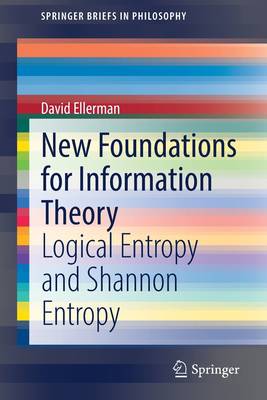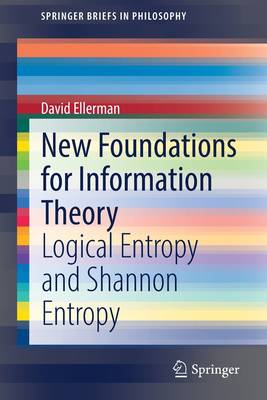
- Retrait gratuit dans votre magasin Club
- 7.000.000 titres dans notre catalogue
- Payer en toute sécurité
- Toujours un magasin près de chez vous
- Retrait gratuit dans votre magasin Club
- 7.000.0000 titres dans notre catalogue
- Payer en toute sécurité
- Toujours un magasin près de chez vous
68,95 €
+ 137 points
Description
This monograph offers a new foundation for information theory that is based on the notion of information-as-distinctions, being directly measured by logical entropy, and on the re-quantification as Shannon entropy, which is the fundamental concept for the theory of coding and communications.
Information is based on distinctions, differences, distinguishability, and diversity. Information sets are defined that express the distinctions made by a partition, e.g., the inverse-image of a random variable so they represent the pre-probability notion of information. Then logical entropy is a probability measure on the information sets, the probability that on two independent trials, a distinction or "dit" of the partition will be obtained.
The formula for logical entropy is a new derivation of an old formula that goes back to the early twentieth century and has been re-derived many times in different contexts. As a probability measure, all the compound notions of joint, conditional, and mutual logical entropy are immediate. The Shannon entropy (which is not defined as a measure in the sense of measure theory) and its compound notions are then derived from a non-linear dit-to-bit transform that re-quantifies the distinctions of a random variable in terms of bits--so the Shannon entropy is the average number of binary distinctions or bits necessary to make all the distinctions of the random variable. And, using a linearization method, all the set concepts in this logical information theory naturally extend to vector spaces in general--and to Hilbert spaces in particular--for quantum logical information theory which provides the natural measure of the distinctions made in quantum measurement.
Relatively short but dense in content, this work can be a reference to researchers and graduate students doing investigations in information theory, maximum entropy methods in physics, engineering, and statistics, and to all those with a special interest in a new approach to quantum information theory.
Information is based on distinctions, differences, distinguishability, and diversity. Information sets are defined that express the distinctions made by a partition, e.g., the inverse-image of a random variable so they represent the pre-probability notion of information. Then logical entropy is a probability measure on the information sets, the probability that on two independent trials, a distinction or "dit" of the partition will be obtained.
The formula for logical entropy is a new derivation of an old formula that goes back to the early twentieth century and has been re-derived many times in different contexts. As a probability measure, all the compound notions of joint, conditional, and mutual logical entropy are immediate. The Shannon entropy (which is not defined as a measure in the sense of measure theory) and its compound notions are then derived from a non-linear dit-to-bit transform that re-quantifies the distinctions of a random variable in terms of bits--so the Shannon entropy is the average number of binary distinctions or bits necessary to make all the distinctions of the random variable. And, using a linearization method, all the set concepts in this logical information theory naturally extend to vector spaces in general--and to Hilbert spaces in particular--for quantum logical information theory which provides the natural measure of the distinctions made in quantum measurement.
Relatively short but dense in content, this work can be a reference to researchers and graduate students doing investigations in information theory, maximum entropy methods in physics, engineering, and statistics, and to all those with a special interest in a new approach to quantum information theory.
Spécifications
Parties prenantes
- Auteur(s) :
- Editeur:
Contenu
- Nombre de pages :
- 113
- Langue:
- Anglais
- Collection :
Caractéristiques
- EAN:
- 9783030865511
- Date de parution :
- 31-10-21
- Format:
- Livre broché
- Format numérique:
- Trade paperback (VS)
- Dimensions :
- 156 mm x 234 mm
- Poids :
- 190 g

Les avis
Nous publions uniquement les avis qui respectent les conditions requises. Consultez nos conditions pour les avis.






